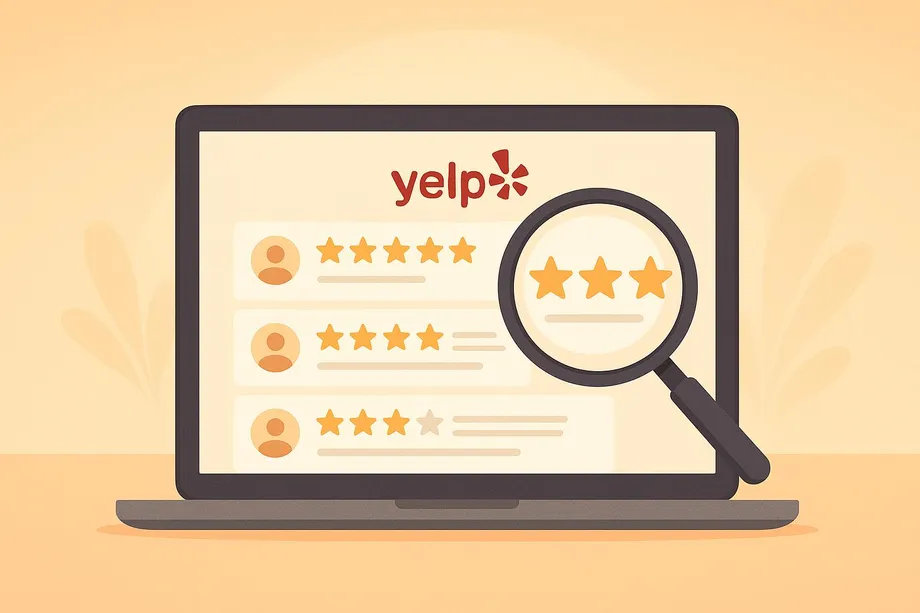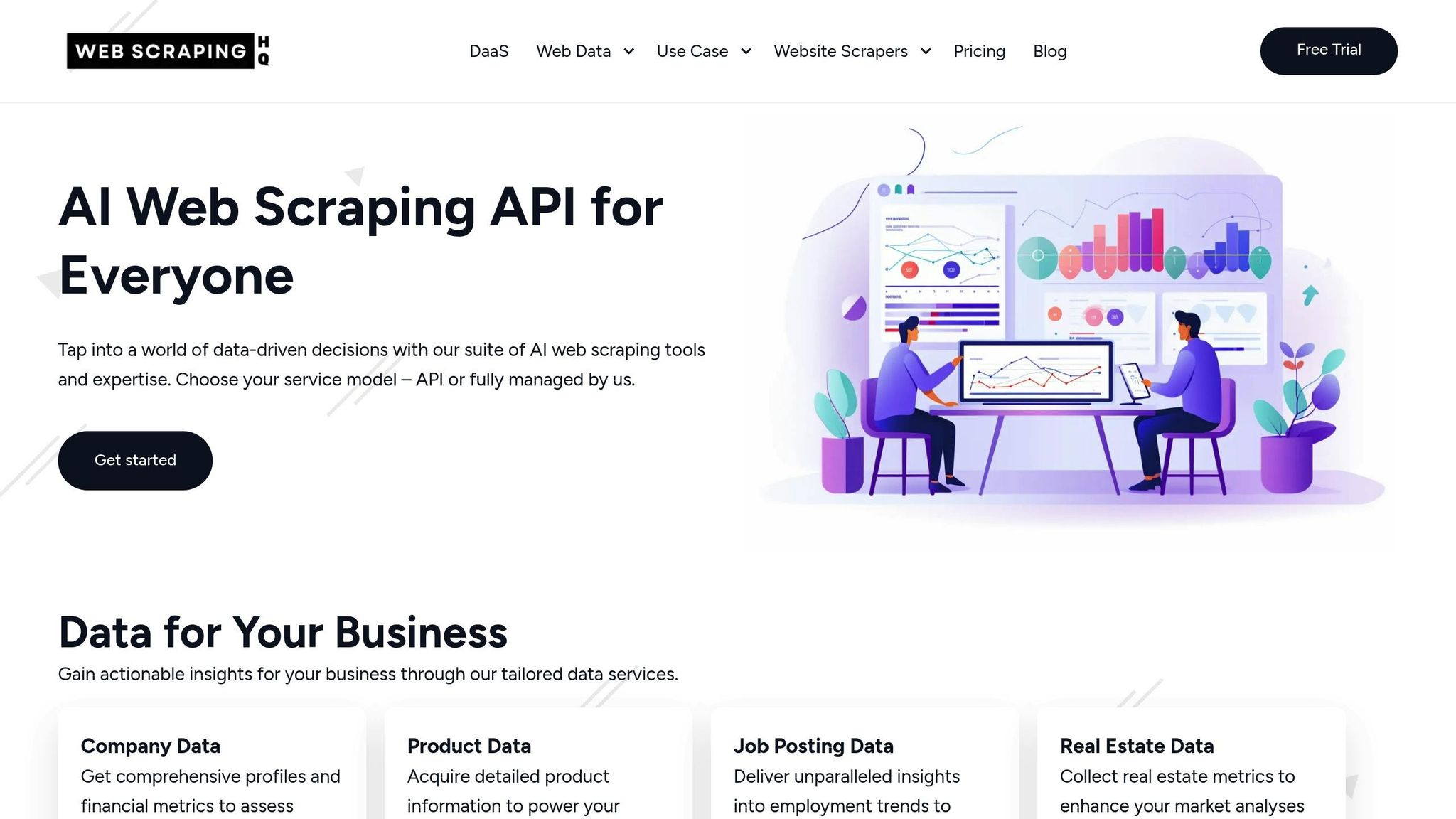
- Harsh Maur
- April 25, 2025
- 7 Mins read
- WebScraping
How to Scrape Yelp Reviews to Understand Your Customers Better?
Scraping Yelp reviews can help businesses understand customer feedback, track competitors, and improve services. With over 184 million reviews, Yelp offers valuable insights into customer experiences. Here's a quick breakdown of what you need to know:
- Why It Matters: Yelp reviews influence reputations and provide real-time insights into customer satisfaction.
-
Benefits of Scraping:
- Analyze thousands of reviews quickly
- Perform sentiment analysis and identify trends
- Track competitors and market positioning
- Compliance: Follow Yelp's rules (no bots or unauthorized scraping) and U.S. data laws like CCPA to avoid legal issues.
-
Getting Started: Use Python libraries like
lxmlandrequeststo extract data such as review text, star ratings, and dates. - Challenges: Overcome rate limits, handle dynamic content, and validate data for consistency.
- Options: Choose between building a DIY scraper or using professional services starting at $449/month for structured data.
Rules and Guidelines
Following legal and compliance requirements ensures ethical data collection and helps maintain access to customer insights responsibly.
Yelp's Usage Rules
Yelp's Terms of Service clearly outline what activities are not allowed when it comes to automated data collection:
| Prohibited Activities | Explanation |
|---|---|
| Automated Access | Using bots, spiders, or scripts without prior approval |
| Data Extraction | Collecting reviews, photos, or business details |
| Browser Extensions | Employing plug-ins to duplicate Yelp content |
| Profile Scraping | Extracting information from user profiles |
U.S. Data Laws
In the U.S., data collection must align with privacy regulations like the CCPA and other state-level laws. These rules emphasize protecting user privacy, obtaining clear consent, and fostering customer trust throughout the process.
Web Scraping HQ's Compliance Methods

- Staying Within Legal Boundaries: Our tools operate within the limits of the law, with thorough checks to ensure compliance.
- Respectful Data Collection: We use structured, rule-abiding methods to deliver insights in formats like JSON or CSV.
- Quality Assurance Measures: Automated checks and expert reviews are in place to maintain data accuracy and compliance.
By observing rate limits, following robots.txt directives, and implementing proper data management practices, businesses can gather review data while staying compliant.
Next, we’ll guide you through starting your review scraping process.
Getting Started with Review Scraping
Setting Clear Goals
Before diving into the technical aspects of review scraping, it's important to outline your objectives. Focus on gathering data that directly supports your business decisions. Here’s a quick breakdown:
| Goal Type | Data Points to Track | Business Impact |
|---|---|---|
| Customer Sentiment | Star ratings, keyword patterns | Improve products |
| Service Quality | Staff mentions, wait times | Identify training needs |
| Location Performance | Branch-specific reviews | Optimize resource use |
| Competitive Analysis | Price mentions, comparisons | Strengthen market position |
Once your goals are clear, you can move on to setting up the technical tools you'll need.
Required Tools and Setup
To get started, install the necessary Python libraries:
pip install lxml requests unicodecsv
These libraries are essential for handling tasks like:
-
HTTP requests: Using
requeststo fetch web pages. -
HTML parsing: Leveraging
lxmlto extract structured data. -
Data export: Using
unicodecsvto save data in readable formats. -
Additional needs: Libraries like
json,urllib.parse, andrefor processing structured data, handling URLs, and pattern matching.
With these tools ready, you can ensure your data collection process is efficient and standardized.
Data Collection Standards
Maintaining consistency in your data collection is key to ensuring high-quality results. When working with U.S.-based review data, follow these guidelines:
- Date Formatting: Use the MM/DD/YYYY format to match U.S. conventions.
- Currency Handling: Standardize price mentions to USD format (e.g., $25.00).
- Character Encoding: Stick to UTF-8 to avoid encoding issues.
- Time Zones: Record timestamps in the appropriate U.S. time zone.
To maintain accuracy, implement automated checks to verify:
- Completeness of review text
- Consistency of star ratings
- Proper date formatting
- Correct business identifiers
- Valid geographic data
How to Scrape Yelp Reviews
Understanding Yelp's Page Layout
To extract data from Yelp effectively, you need to familiarize yourself with its HTML structure. Yelp combines static HTML with dynamic JSON data, so identifying the right elements is key. Here are some of the critical components to focus on:
| Element | HTML Location | Data Type |
|---|---|---|
| Review Text | .review-content p |
Text content |
| Star Rating | .rating-large |
Numeric value |
| Review Date | .rating-qualifier |
Formatted date |
| Business Info | .biz-page-header |
Mixed content |
| User Details | .user-passport |
Profile data |
Creating a Basic Scraper
To get started, you'll need a well-structured scraper that uses the right libraries and setup. Below is a simple example to help you begin:
import requests
from lxml import html
def setup_scraper():
headers = {
'User-Agent': 'Mozilla/5.0 (Windows NT 10.0; Win64; x64)',
'Accept': 'text/html,application/json'
}
return headers
def extract_reviews(url, headers):
response = requests.get(url, headers=headers)
if response.status_code == 200:
tree = html.fromstring(response.content)
reviews = tree.xpath('//div[@class="review-content"]')
return reviews
Once your scraper is set up, you can start addressing common challenges that come with scraping Yelp reviews.
Overcoming Common Issues
Scraping Yelp reviews isn't without its hurdles. Here are some frequent issues and how to tackle them:
- Rate Limiting: Add a delay of 3-5 seconds between requests to avoid being blocked.
-
Dynamic Content: For JavaScript-rendered data, ensure you:
- Use proper request headers.
- Allow time for the content to load.
- Parse JSON data embedded within the HTML.
-
Data Validation: Clean up extracted data by:
- Using regular expressions to match patterns.
- Ensuring UTF-8 encoding for text.
- Converting dates to the MM/DD/YYYY format for consistency.
If these challenges become overwhelming, professional tools can make the process much easier.
Using Professional Scraping Services
For those looking to scrape Yelp reviews at scale without constant manual effort, professional scraping services can be a practical solution. These services handle the complexities for you, offering reliable and efficient data extraction.
| Feature | Advantage |
|---|---|
| Automated Extraction | Regular updates without manual effort |
| Quality Assurance | Verified and accurate data |
| Compliance Handling | Ensures adherence to Yelp's terms of service |
| Data Formatting | Delivers structured JSON or CSV outputs |
| Scalable Solutions | Manages large volumes of data seamlessly |
For example, our Standard Plan costs $449/month and delivers structured data within 5 business days. If you need faster results, the Custom Plan starts at $999/month and offers delivery within 24 hours.
sbb-itb-65bdb53
Using Review Data Effectively
Organizing Raw Data
To analyze Yelp reviews effectively, start by organizing the raw data into standardized fields. Here's a simple structure to follow:
| Field | Format | Example |
|---|---|---|
| Review Date | MM/DD/YYYY | 04/25/2025 |
| Star Rating | Numeric (1-5) | 4.5 |
| Review Text | UTF-8 encoded | "Great service!" |
| Location | City, State | San Francisco, CA |
| Business Category | Text | Restaurant |
| User Info | Username | john_doe_sf |
Make sure to clean the data by removing duplicates and ensuring consistent formatting. Adjust timestamps to match the relevant U.S. time zone for more accurate location-based insights. Once your data is organized, you'll have a solid foundation for identifying trends and patterns.
Finding Patterns in Reviews
With structured data, it's easier to uncover customer sentiments and recurring themes.
Sentiment Analysis
Analyze sentiment trends by focusing on:
- Star rating distributions over time
- Keywords that appear frequently in positive and negative reviews
- Seasonal shifts in customer satisfaction
- Feedback related to specific business changes
Topic Identification
Leverage natural language processing tools to group reviews by themes such as:
- Mentions of service quality
- Comments on specific products
- Feedback about pricing
- Remarks on location and accessibility
Categorizing reviews (e.g., food quality, service speed) helps pinpoint areas for improvement quickly.
DIY vs. Professional Services
When deciding between a DIY approach and professional services, consider factors like setup time, cost, and scalability. Here's a comparison:
| Aspect | DIY Approach | Professional Service |
|---|---|---|
| Setup Time | About 2-3 weeks | 5 business days |
| Data Quality | Requires manual verification | Includes double-layer quality checks |
| Cost Range | $0–200/month (tools) | Starts at $449/month |
| Technical Requirements | Python knowledge needed | No technical skills required |
| Scalability | Limited by resources | Handles large volumes |
| Update Frequency | Manual updates | Automated daily updates |
For businesses processing up to 10,000 reviews a month, the Standard Plan at $449/month is a great option. It offers structured data delivery in just 5 business days. Larger businesses needing faster insights can opt for the Custom Plan starting at $999/month, which includes 24-hour delivery and advanced analysis tools.
Data Processing Tips:
- Export data in CSV or JSON formats for flexibility
- Set up alerts to flag patterns in negative reviews
- Create weekly summaries of key metrics
- Track historical trends for deeper insights
- Use custom dashboards for real-time monitoring
Conclusion
Scraping Yelp reviews has become a key strategy for businesses aiming to understand customer behavior and boost revenue. With over 184 million reviews and more than 5 million businesses listed on Yelp, the platform offers a wealth of data to analyze market trends and customer preferences.
Web Scraping HQ simplifies this process with managed services that include automated updates, structured data delivery, double-layer quality checks, and strict compliance monitoring. These services ensure accurate and lawful data collection.
With Yelp ranked as the 44th most visited site, its reviews are a treasure trove of customer feedback. A systematic approach to scraping and analyzing this data allows businesses to better understand their audience and make smarter decisions to enhance performance.
FAQs
Get all your questions answered about our Data as a Service solutions. From understanding our capabilities to project execution, find the information you need to make an informed decision.
Here are the steps to scrape Yelp.
- Visit Webscraping HQ website
- Sign Up and Obtain Your API Key
- Send a Scraping Request by adding an url which you want to scrape.
- Receive and Download the Scraped Data
Yes , It is legal to scrape Google. There is no such law which prohibits scraping of publicly available data.
Here are the steps to scrape any data.
- Visit Webscraping HQ website
- Sign Up and Obtain Your API Key
- Send a Scraping Request by adding an url which you want to scrape.
- Receive and Download the Scraped Data